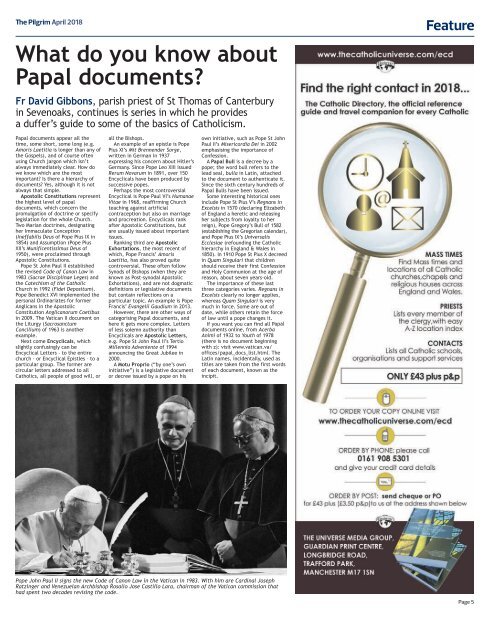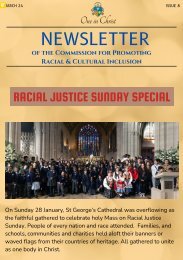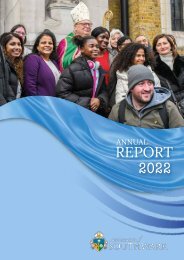Issue 70 - The Pilgrim - April 2018 - The newspaper of the Archdiocese of Southwark
The April 2018 issue of "The Pilgrim", the newspaper of the Archdiocese of Southwark
The April 2018 issue of "The Pilgrim", the newspaper of the Archdiocese of Southwark
You also want an ePaper? Increase the reach of your titles
YUMPU automatically turns print PDFs into web optimized ePapers that Google loves.
<strong>The</strong> <strong>Pilgrim</strong> <strong>April</strong> <strong>2018</strong><br />
What do you know about<br />
Papal documents?<br />
Fr David Gibbons, parish priest <strong>of</strong> St Thomas <strong>of</strong> Canterbury<br />
in Sevenoaks, continues is series in which he provides<br />
a duffer’s guide to some <strong>of</strong> <strong>the</strong> basics <strong>of</strong> Catholicism.<br />
Feature<br />
Papal documents appear all <strong>the</strong><br />
time, some short, some long (e.g.<br />
Amoris Laetitia is longer than any <strong>of</strong><br />
<strong>the</strong> Gospels), and <strong>of</strong> course <strong>of</strong>ten<br />
using Church jargon which isn’t<br />
always immediately clear. How do<br />
we know which are <strong>the</strong> most<br />
important? Is <strong>the</strong>re a hierarchy <strong>of</strong><br />
documents? Yes, although it is not<br />
always that simple.<br />
Apostolic Constitutions represent<br />
<strong>the</strong> highest level <strong>of</strong> papal<br />
documents, which concern <strong>the</strong><br />
promulgation <strong>of</strong> doctrine or specify<br />
legislation for <strong>the</strong> whole Church.<br />
Two Marian doctrines, designating<br />
her Immaculate Conception<br />
(Ineffabilis Deus <strong>of</strong> Pope Pius IX in<br />
1854) and Assumption (Pope Pius<br />
XII’s Munificentissimus Deus <strong>of</strong><br />
1950), were proclaimed through<br />
Apostolic Constitutions.<br />
Pope St John Paul II established<br />
<strong>the</strong> revised Code <strong>of</strong> Canon Law in<br />
1983 (Sacrae Disciplinae Leges) and<br />
<strong>the</strong> Catechism <strong>of</strong> <strong>the</strong> Catholic<br />
Church in 1992 (Fidei Depositum).<br />
Pope Benedict XVI implemented <strong>the</strong><br />
personal Ordinariates for former<br />
Anglicans in <strong>the</strong> Apostolic<br />
Constitution Anglicanorum Coetibus<br />
in 2009. <strong>The</strong> Vatican II document on<br />
<strong>the</strong> Liturgy (Sacrosanctum<br />
Concilium) <strong>of</strong> 1963 is ano<strong>the</strong>r<br />
example.<br />
Next come Encyclicals, which<br />
slightly confusingly can be<br />
Encyclical Letters – to <strong>the</strong> entire<br />
church - or Encyclical Epistles – to a<br />
particular group. <strong>The</strong> former are<br />
circular letters addressed to all<br />
Catholics, all people <strong>of</strong> good will, or<br />
all <strong>the</strong> Bishops.<br />
An example <strong>of</strong> an epistle is Pope<br />
Pius XI’s Mit Brennender Sorge,<br />
written in German in 1937<br />
expressing his concern about Hitler’s<br />
Germany. Since Pope Leo XIII issued<br />
Rerum Novarum in 1891, over 150<br />
Encyclicals have been produced by<br />
successive popes.<br />
Perhaps <strong>the</strong> most controversial<br />
Encyclical is Pope Paul VI’s Humanae<br />
Vitae in 1968, reaffirming Church<br />
teaching against artificial<br />
contraception but also on marriage<br />
and procreation. Encyclicals rank<br />
after Apostolic Constitutions, but<br />
are usually issued about important<br />
issues.<br />
Ranking third are Apostolic<br />
Exhortations, <strong>the</strong> most recent <strong>of</strong><br />
which, Pope Francis’ Amoris<br />
Laetitia, has also proved quite<br />
controversial. <strong>The</strong>se <strong>of</strong>ten follow<br />
Synods <strong>of</strong> Bishops (when <strong>the</strong>y are<br />
known as Post-synodal Apostolic<br />
Exhortations), and are not dogmatic<br />
definitions or legislative documents<br />
but contain reflections on a<br />
particular topic. An example is Pope<br />
Francis’ Evangelii Gaudium in 2013.<br />
However, <strong>the</strong>re are o<strong>the</strong>r ways <strong>of</strong><br />
categorising Papal documents, and<br />
here it gets more complex. Letters<br />
<strong>of</strong> less solemn authority than<br />
Encyclicals are Apostolic Letters,<br />
e.g. Pope St John Paul II’s Tertio<br />
Millennio Adveniente <strong>of</strong> 1994<br />
announcing <strong>the</strong> Great Jubilee in<br />
2000.<br />
A Motu Proprio (“by one’s own<br />
initiative”) is a legislative document<br />
or decree issued by a pope on his<br />
own initiative, such as Pope St John<br />
Paul II’s Misericordia Dei in 2002<br />
emphasising <strong>the</strong> importance <strong>of</strong><br />
Confession.<br />
A Papal Bull is a decree by a<br />
pope; <strong>the</strong> word bull refers to <strong>the</strong><br />
lead seal, bulla in Latin, attached<br />
to <strong>the</strong> document to au<strong>the</strong>nticate it.<br />
Since <strong>the</strong> sixth century hundreds <strong>of</strong><br />
Papal Bulls have been issued.<br />
Some interesting historical ones<br />
include Pope St Pius V’s Regnans in<br />
Excelsis in 15<strong>70</strong> (declaring Elizabeth<br />
<strong>of</strong> England a heretic and releasing<br />
her subjects from loyalty to her<br />
reign), Pope Gregory’s Bull <strong>of</strong> 1582<br />
(establishing <strong>the</strong> Gregorian calendar),<br />
and Pope Pius IX’s Universalis<br />
Ecclesiae (refounding <strong>the</strong> Catholic<br />
hierarchy in England & Wales in<br />
1850). In 1910 Pope St Pius X decreed<br />
in Quam Singulari that children<br />
should receive <strong>the</strong>ir first Confession<br />
and Holy Communion at <strong>the</strong> age <strong>of</strong><br />
reason, about seven years-old.<br />
<strong>The</strong> importance <strong>of</strong> <strong>the</strong>se last<br />
three categories varies. Regnans in<br />
Excelsis clearly no longer applies,<br />
whereas Quam Singulari is very<br />
much in force. Some are out <strong>of</strong><br />
date, while o<strong>the</strong>rs retain <strong>the</strong> force<br />
<strong>of</strong> law until a pope changes it.<br />
If you want you can find all Papal<br />
documents online, from Acerba<br />
Animi <strong>of</strong> 1932 to Youth <strong>of</strong> 1978<br />
(<strong>the</strong>re is no document beginning<br />
with z): visit www.vatican.va/<br />
<strong>of</strong>fices/papal_docs_list.html. <strong>The</strong><br />
Latin names, incidentally, used as<br />
titles are taken from <strong>the</strong> first words<br />
<strong>of</strong> each document, known as <strong>the</strong><br />
incipit.<br />
Pope John Paul II signs <strong>the</strong> new Code <strong>of</strong> Canon Law in <strong>the</strong> Vatican in 1983. With him are Cardinal Joseph<br />
Ratzinger and Venezuelan Archbishop Rosalio Jose Castillo Lara, chairman <strong>of</strong> <strong>the</strong> Vatican commission that<br />
had spent two decades revising <strong>the</strong> code.<br />
Page 5


















